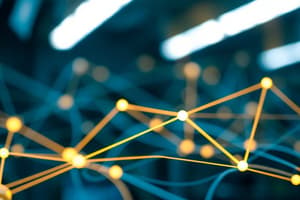Podcast
Questions and Answers
Which network topology involves devices connected in a loop?
Which network topology involves devices connected in a loop?
- Ring topology (correct)
- Bus topology
- Mesh topology
- Star topology
What is the primary function of routers in a network?
What is the primary function of routers in a network?
- To forward data packets between networks (correct)
- To convert digital signals to analog signals
- To broadcast data to all devices
- To connect devices on a local area network
Which layer of the OSI model is responsible for error handling and data flow control?
Which layer of the OSI model is responsible for error handling and data flow control?
- Network layer
- Physical layer
- Transport layer (correct)
- Session layer
Which type of device is primarily used to improve network performance by forwarding data to specific recipients?
Which type of device is primarily used to improve network performance by forwarding data to specific recipients?
What is a common security threat that can disrupt network functionality?
What is a common security threat that can disrupt network functionality?
Which device modulates and demodulates signals for data transmission?
Which device modulates and demodulates signals for data transmission?
What security measure acts as a barrier to outside network threats?
What security measure acts as a barrier to outside network threats?
What is the main purpose of network interface cards (NICs)?
What is the main purpose of network interface cards (NICs)?
What is the primary purpose of encryption in data transmission?
What is the primary purpose of encryption in data transmission?
Which of the following accurately describes subnetting?
Which of the following accurately describes subnetting?
What does latency refer to in network communication?
What does latency refer to in network communication?
Which of the following best describes the Client-Server model?
Which of the following best describes the Client-Server model?
What is the function of MAC addresses in a network?
What is the function of MAC addresses in a network?
Which protocol is primarily used for transferring web pages?
Which protocol is primarily used for transferring web pages?
Which type of cable offers the highest bandwidth and longest transmission distance?
Which type of cable offers the highest bandwidth and longest transmission distance?
In network troubleshooting, what is the primary goal?
In network troubleshooting, what is the primary goal?
Flashcards
Network Topologies
Network Topologies
Physical arrangements of devices in a network, like bus, star, ring, mesh, and tree. Each has advantages and disadvantages in terms of fault tolerance, performance, and cost.
Networking Protocols
Networking Protocols
Sets of rules that govern data transmission and reception on a network. Examples include TCP/IP, HTTP, and FTP.
Network Layers (OSI Model)
Network Layers (OSI Model)
A conceptual model describing the layers of functionality in a communication system. Each layer has specific tasks, working together to facilitate data transfer.
Routers
Routers
Signup and view all the flashcards
Switches
Switches
Signup and view all the flashcards
Firewalls
Firewalls
Signup and view all the flashcards
Network Security Threats
Network Security Threats
Signup and view all the flashcards
Network Security Measures
Network Security Measures
Signup and view all the flashcards
Encryption
Encryption
Signup and view all the flashcards
IP Addresses
IP Addresses
Signup and view all the flashcards
Subnetting
Subnetting
Signup and view all the flashcards
Bandwidth
Bandwidth
Signup and view all the flashcards
Latency
Latency
Signup and view all the flashcards
Client-Server Model
Client-Server Model
Signup and view all the flashcards
Peer-to-Peer (P2P)
Peer-to-Peer (P2P)
Signup and view all the flashcards
Fiber Optic Cables
Fiber Optic Cables
Signup and view all the flashcards
Study Notes
Networking Concepts
- Network Topologies: Different physical arrangements of devices in a network. Common topologies include bus, star, ring, mesh, and tree. Each has advantages and disadvantages related to fault tolerance, performance, and cost.
- Networking Protocols: Sets of rules that govern how data is transmitted and received across a network. Examples include TCP/IP (Transmission Control Protocol/Internet Protocol), HTTP (Hypertext Transfer Protocol), FTP (File Transfer Protocol), and others. These protocols define how devices format data, address it, and handle errors.
- Network Layers (OSI Model): A conceptual model that describes the different layers of functionality in a communication system. Each layer has specific tasks; the layers work together to facilitate data transfer. The seven layers include the physical, data link, network, transport, session, presentation, and application layers. Understanding these layers helps in troubleshooting network issues.
Network Devices
- Routers: Devices that forward data packets between networks based on their destination addresses. Crucial for routing traffic across the internet.
- Switches: Devices that connect multiple devices on a local area network (LAN) and forward data only to the intended recipient. Switches improve network performance by reducing collisions.
- Hubs: A relatively simple device that connects multiple devices together. Hubs broadcast data packets to all connected devices, which is less efficient than switches.
- Modems: Devices that modulate and demodulate signals to enable data transmission over communication lines (like phone lines or cable). Modems convert digital data from a computer to analog signals for transmission and vice-versa.
- Network Interface Cards (NICs): Hardware components in devices that allow them to communicate on a network. They provide the physical connection to the network infrastructure.
Network Security
- Security Threats: Various threats like malware (viruses, worms, trojans), denial-of-service attacks, and unauthorized access attempts. Protecting networks from these threats is essential to maintain data integrity and confidentiality.
- Security Measures: Methods to protect networks from threats. These measures include firewalls, intrusion detection systems (IDS), anti-virus software, access controls, and encryption.
- Firewalls: Hardware or software that act as a barrier between a network and the outside world. They control incoming and outgoing network traffic based on predefined rules.
- Encryption: The process of encoding data to prevent unauthorized access. It makes data unreadable without the decryption key.
Network Addressing
- IP Addresses: Unique numerical labels assigned to devices on a network to enable communication. IPv4 and IPv6 are two common versions of IP addressing.
- Subnetting: Dividing a large network into smaller subnetworks to improve efficiency and security.
- MAC Addresses: Unique hardware addresses assigned to network interface cards (NICs). MAC addresses are used for local communication within a LAN.
Network Concepts
- Bandwidth: The amount of data that can be transmitted over a network in a given time. Measured in bits per second (bps).
- Latency: Delay in transmitting data across a network. Latency is a crucial factor in real-time applications.
- Network Management: Monitoring, configuring, and maintaining computer networks. Network management involves keeping networks operational, optimizing performance, and ensuring security.
- Network Troubleshooting: Techniques to identify and resolve issues in a network.
Network Protocols in Detail (Examples)
- TCP/IP: A suite of protocols that defines how data is communicated across the internet. TCP handles reliable transmission, while IP handles addressing and routing.
- HTTP: Used for transferring web pages and other hypermedia content over the World Wide Web.
- FTP: A protocol used for transferring files over a network. FTP has both active and passive modes.
Network Models (Examples)
- Client-Server Model: A model where a client (a device requesting data) interacts with a server (a device providing the data). This is common for web applications.
- Peer-to-Peer (P2P): A distributed model where devices function as both clients and servers. Napster is an example.
Network Media
- Copper Cables: Twisted-pair wires and coaxial cables are types of copper cables used to transmit data in networks. Copper cables are common for short-range networks, like Ethernet.
- Fiber Optic Cables: Transmit data as light pulses. Fiber optic cables offer higher bandwidth and longer transmission distances compared to copper cables.
- Wireless Media: Transmit data using radio waves. Wireless networks, like WiFi (IEEE 802.11), operate over radio frequencies.
Studying That Suits You
Use AI to generate personalized quizzes and flashcards to suit your learning preferences.




